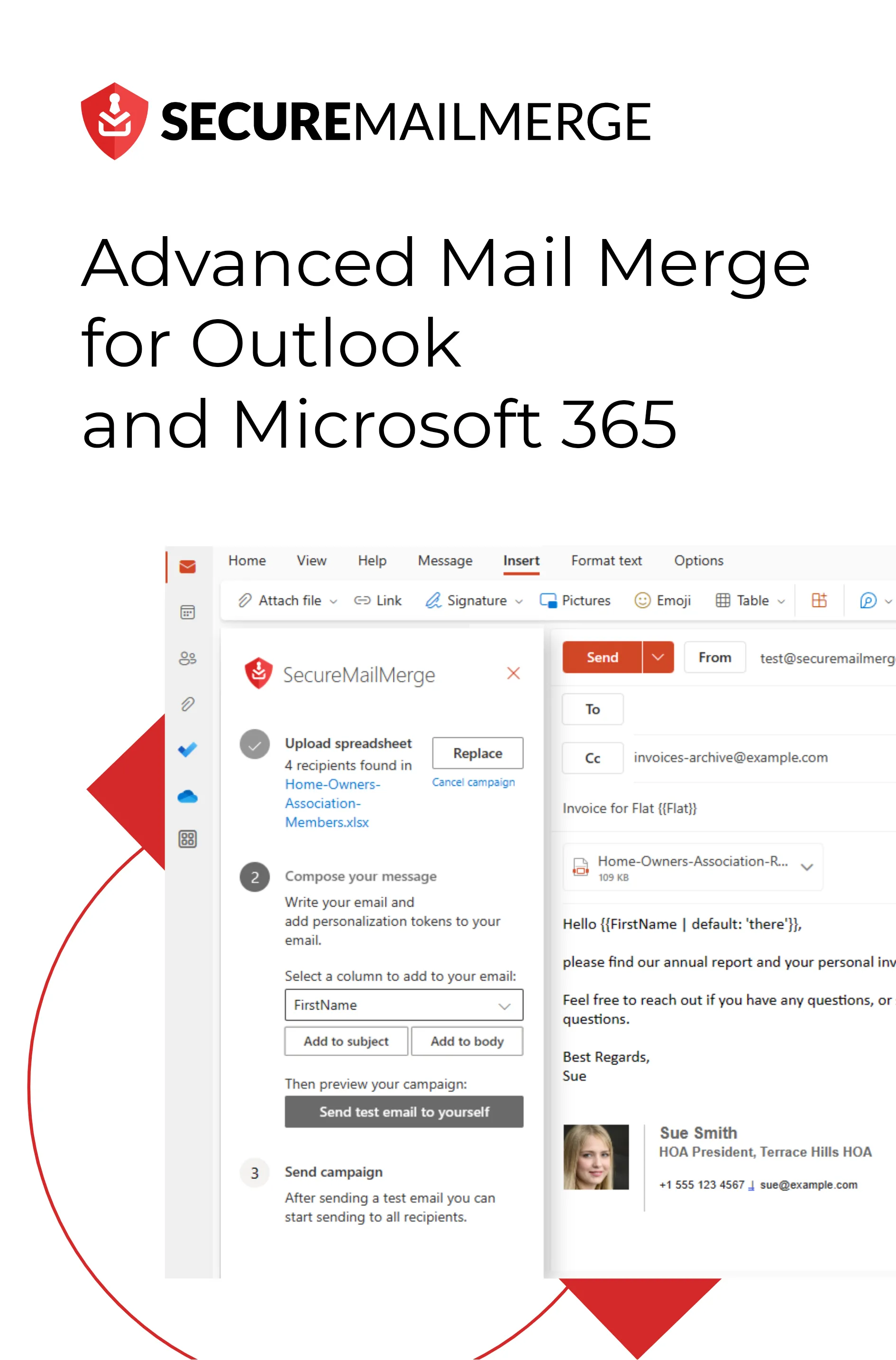Know how directly from the Microsoft 365 mail merge experts
How to Create A Winning Email Marketing Strategy in 2023
With over 4.37 billion email users, email marketing has become one of the most effective digital tools for businesses to engage with their audience. An email marketing strategy can increase brand loyalty and drive conversions if employed correctly. And in this article, we’ll unwind on how to create a winning email marketing strategy.
With billions of people using email worldwide, it offers a unique opportunity to connect with customers and generate leads. That’s because it allows businesses to customize their outreach, tailoring their communication across various market segments and their audience placement within the sales marketing funnel.
By the end of this guide, you’ll have learned the following:
- What is an email marketing strategy
- The ins and outs of creating a successful email marketing strategy,
- 5 benefits of an email marketing strategy
- 6 elements of a successful email marketing strategy,
- 12 best practices to drive results,
- recommended tools and software,
- And real-world examples of successful email marketing campaigns.
Let’s start!
What is an Email Marketing Strategy?
An email marketing strategy is a plan of action that outlines how a business will use email marketing to achieve their brand growth goals.
It involves the following:
- Identifying the target audience,
- Developing a message,
- Creating an email list,
- Setting objectives for the email campaign,
- Defining metrics for success,
- Selecting email marketing software and tools,
- Creating a schedule for sending emails.
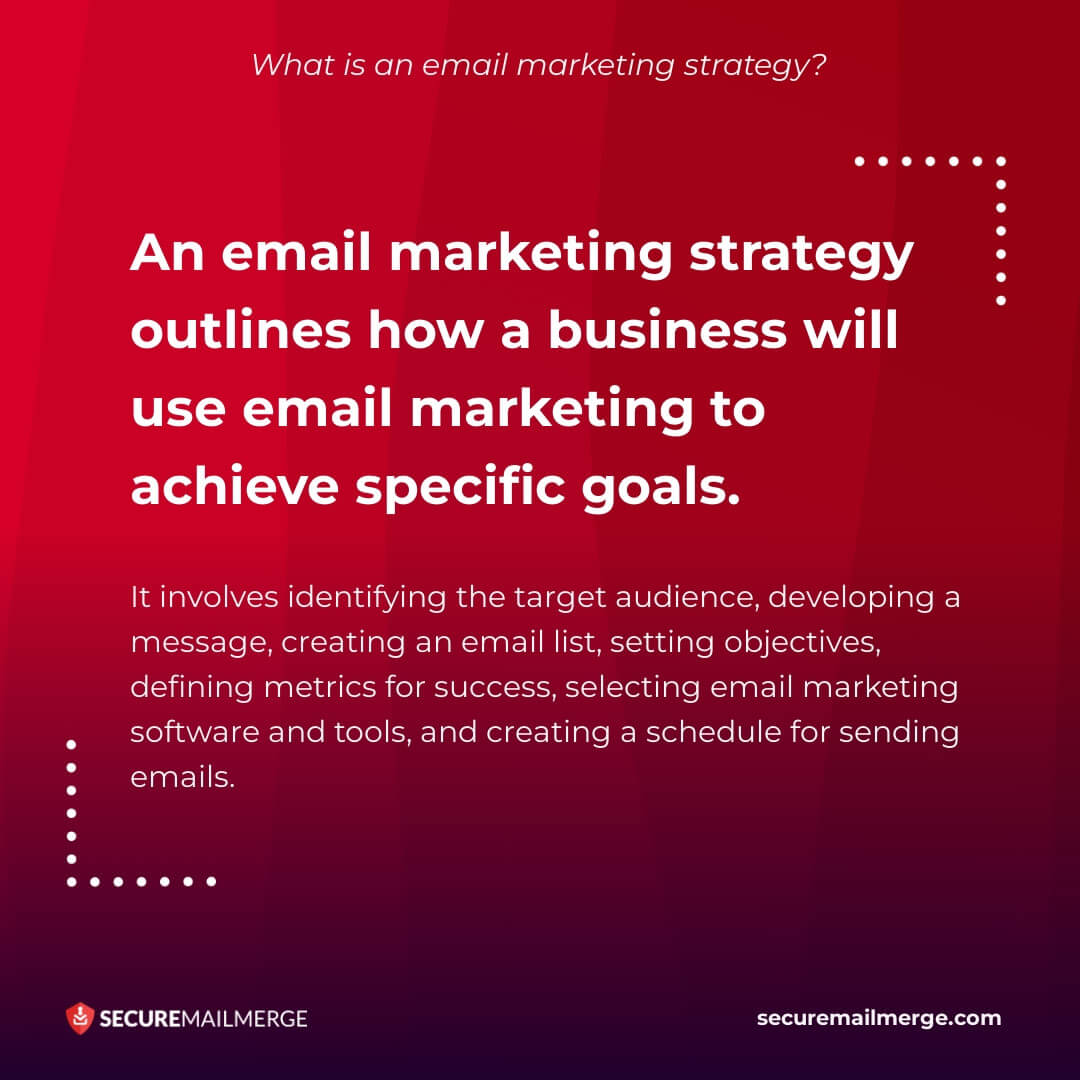
A well-designed email marketing strategy can help increase brand awareness, drive traffic to a website, generate leads, and boost sales. A good email marketing strategy should also address personalizing and segmenting emails to increase engagement and conversions.
It is essential to continuously evaluate and adjust the strategy to optimize performance and achieve the desired results.
Email campaigns play a crucial role in inbound marketing, which embraces engaging with potential buyers at any stage of their journey. Recognizing that immediate purchasing readiness varies, email is a vital channel for maintaining a presence.
Email lets you keep your brand at the forefront of recipients’ minds by delivering personalized messages directly to their inboxes. Leveraging marketing automation tools like SecureMailMerge for Outlook 365, or MailChimp, you can achieve this communication on a large scale.
5 Benefits Of A Well-Crafted Email Marketing Strategy
A well-crafted email marketing strategy can profoundly impact your business across multiple fronts.
Some of the key benefits include:
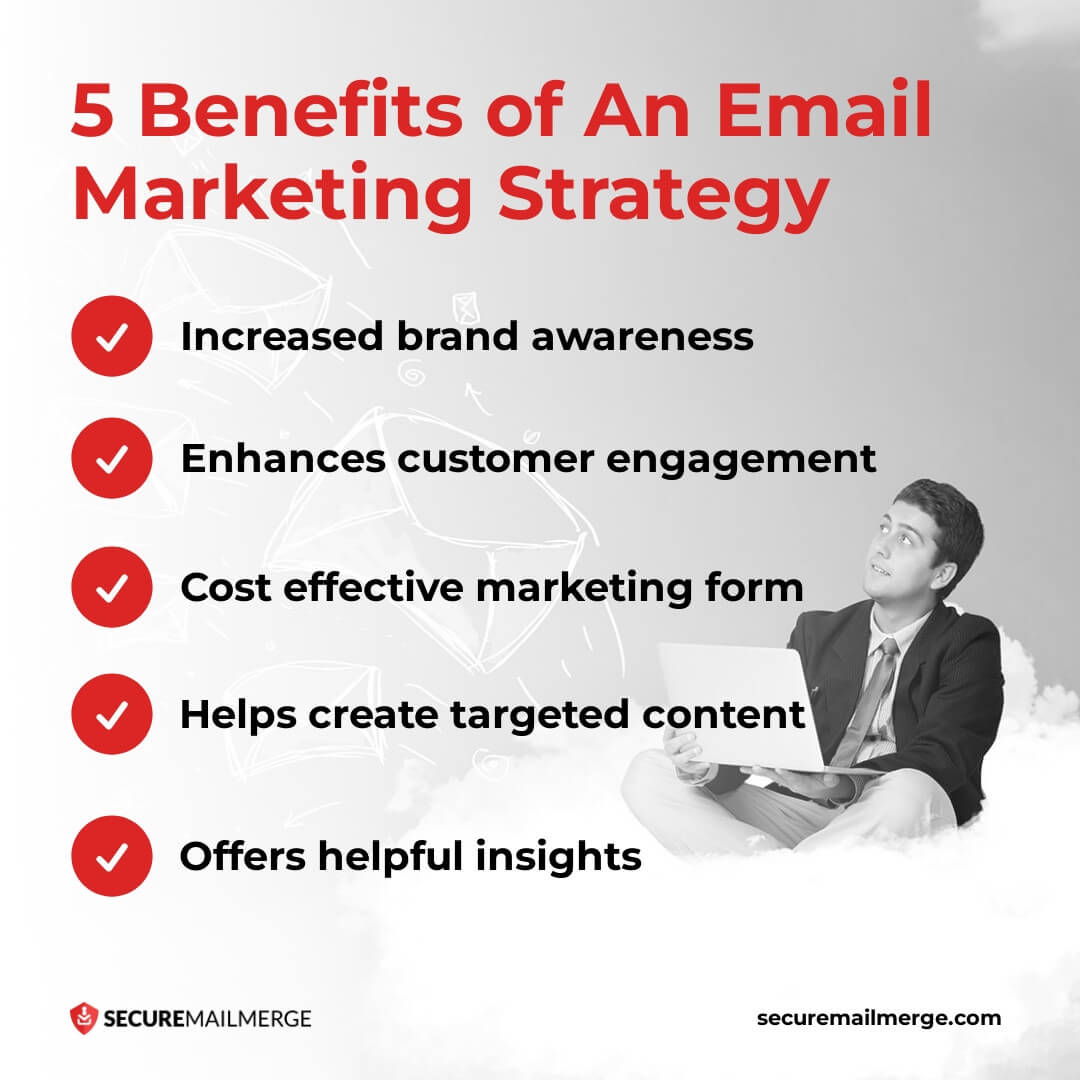
1. Increased Reach and Brand Awareness
Email marketing allows businesses to connect with a large audience instantly. With billions of active email users worldwide, businesses can reach potential customers from different demographics and geographic locations, expanding their reach beyond traditional marketing channels.
Businesses can tap into various customer profiles by creating engagement products such as customer feedback forms, rewards program enrolment, newsletter subscriptions, or retail intake forms for online orders. These profiles give companies insight into a vast network of past, present, and potential customers.
2. Enhanced Customer Engagement
Email campaigns provide an excellent opportunity to engage with customers personally. By delivering relevant and valuable content directly to their inboxes, your business can foster a sense of loyalty, trust, and brand affinity among its subscribers.
For example, A local cosmetics brand might send monthly newsletters with tutorials on creating popular makeup looks using their products. Subscribers may include past customers or even just cosmetics enthusiasts. So long as the content delivers value, engaged audiences are more likely to convert, become repeat buyers, or advocate for the brand.
3. Cost-Effective Marketing
Compared to traditional marketing channels, email marketing offers a cost-effective solution. It eliminates the need for printing, advertising space, or sponsored content, making it a budget-friendly option for businesses of all sizes. Automating this process can save your business valuable time while ensuring meaningful outreach and easy campaign tracking.
Instead of paying for various targeted ads for different demographics, a built-in mail merge plugin, such as Secure MailMerge for Outlook users, can easily customize emails and store information all in one place.
4. Helps You Create Targeted and Customized Content
Email marketing allows for the segmentation of subscriber lists based on demographics, preferences, or behaviors.
The month of December calls for very different fashion choices in New York City compared to, say, Sydney, Australia. Therefore, a global clothing brand could send relevant offers according to its customers’ geographic location, catering to its various customer bases’ unique circumstances, needs, and interests to drive higher engagement and conversions.
5. Offers Helpful Insights
Email marketing platforms provide valuable analytics and reporting features that allow you to measure the success of your campaigns.
Example: By tracking metrics such as open rates, click-through rates, and conversions, businesses gain actionable insights on what works and what doesn’t. The performance of a given campaign can then be evaluated in terms of the types of content, designs, and CTAs that lead to greater conversions.
Successful Examples of Real-World Email Marketing
Spotify
Spotify regularly sends its users emails to draw attention to new app features, customized playlists, and new music releases. These emails are short, easy to skim through, and contain CTA buttons to drive traffic back to their streaming platform.
Why it works: Spotify’s ability to personalize its emails based on users’ listening preferences and interests creates a sense of exclusivity and relevance, fostering greater brand loyalty. Each suggestion has an identifiable CTA button, ensuring users know precisely what they’re getting when clicking.
Starbucks
Simple, short, and concise, the Starbucks monthly newsletter typically consists of just one hero image, followed by a CTA prompting the audience to explore more. The hero image generally is a new or seasonal item.
Why it works: By featuring just one hero image, usually showcasing a new or seasonal item, Starbucks captures attention and generates curiosity. The singular focus allows the audience to comprehend the main message without distractions easily. Including a clear and compelling call-to-action (CTA) encourages readers to explore further, driving them to visit Starbucks stores or its online platforms.
Sephora
Sephora’s email marketing strategy revolves around providing value to its subscribers. They send personalized product recommendations based on previous purchases, exclusive offers, beauty tips, and tutorial videos.
Why it works: By tailoring its emails to individual preferences and needs, Sephora creates a sense of community and loyalty in its audience. The focus of the newsletter is on building long-term relationships by delivering valuable content that goes beyond just selling products.
6 Steps to Ensure an Effective Email Marketing Strategy
An effective email marketing strategy can help businesses achieve their goals and build strong relationships with their audience. Like any effective marketing campaign, it requires careful planning, execution, and continuous optimization.
To ensure the success of your email marketing campaigns, define your objectives and target audience, optimize for mobile devices, personalize content, and regularly test and analyze results.
Follow the below steps to drive business growth through personalized and engaging email content.
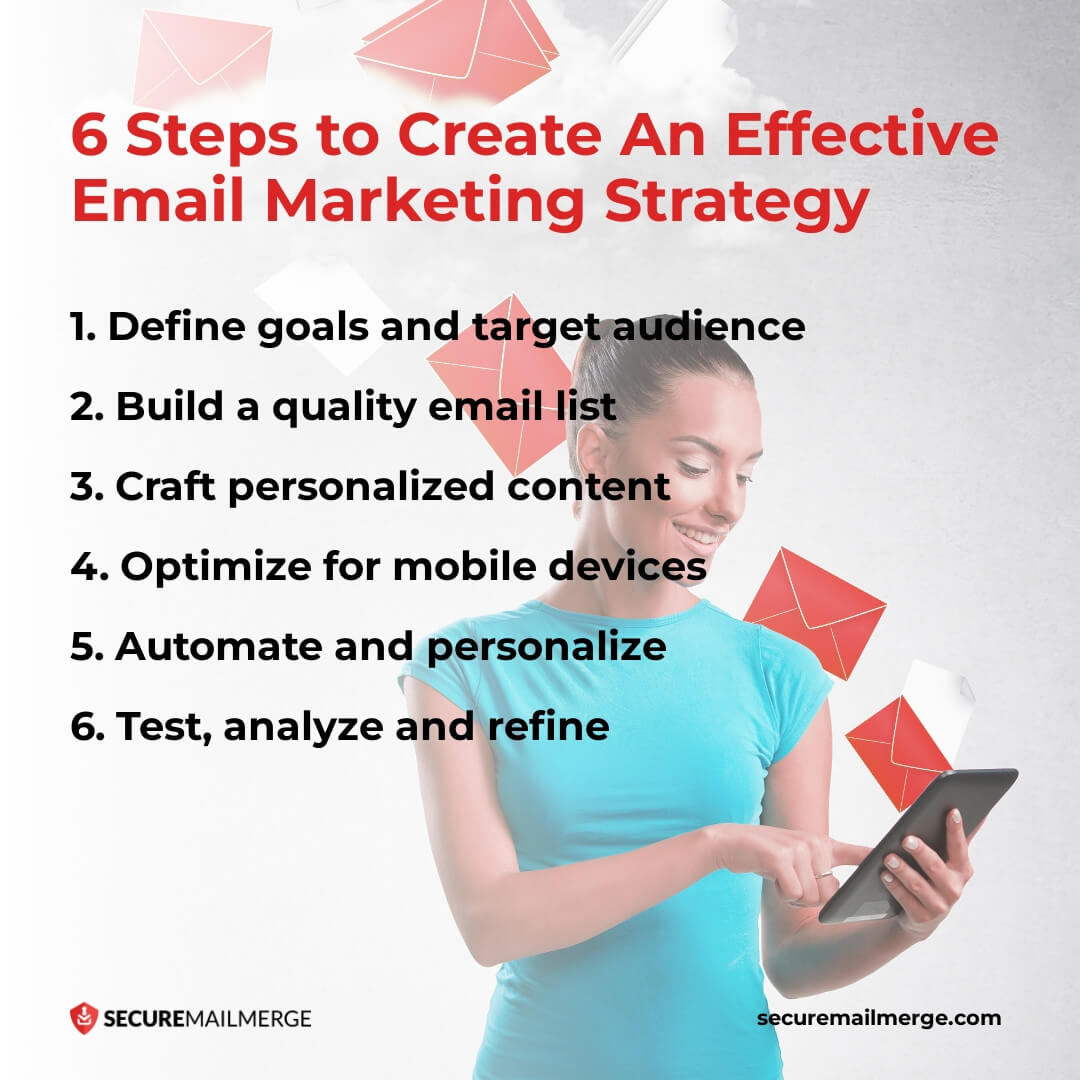
Step 1: Define Goals and Target Audience
Before diving into email marketing, it’s essential to define clear objectives. Identify your end goal: are you aiming to drive sales, increase brand awareness, promote a new product, or nurture customer relationships?
Once you have a clear goal in mind, identify a target audience. Understand their needs, preferences, and pain points to ensure your emails resonate with them effectively.
Step 2: Build a Quality Email List
An email list is the foundation of a good email marketing strategy. Focus on growing an organic list of engaged subscribers who have willingly opted to receive your communications.
One way to capture this customer data is to offer incentives like exclusive content, discounts, or valuable resources to encourage sign-ups. It’s also important to regularly clean the list to maintain quality, update it according to changing business goals, and remove inactive or unengaged subscribers.
Step 3: Craft Compelling and Personalized Content
Engaging content is at the heart of a successful email marketing strategy. This is your brand’s direct interaction with the customer. Use a conversational tone and make your emails personal and relatable. These emails should align with your audience’s interests, provide value, and evoke excitement.
Conversion can be something other than the goal here. Instead, build relationships and trust with your subscribers through valuable and relevant content. Incorporate storytelling, educational content, promotional offers, or curated recommendations to captivate your readers.
Step 4: Optimize for Mobile Devices
Given the increasing use of smartphones, optimizing emails for mobile is crucial. Most email opens now happen on mobile devices, so ensuring your emails are responsive and displayed correctly on various devices and email clients is essential.
Use concise subject lines, clear call-to-action buttons, and visually appealing designs to enhance the mobile user experience. Test your emails across different devices to ensure optimal readability and functionality.
Step 5: Automate and Personalize
Leverage automation tools to streamline your email marketing efforts and enhance personalization. Set up automated welcome emails to greet new subscribers and introduce them to your brand. Other automation can include emails based on specific actions or milestones, such as abandoned carts, birthdays, or purchase history.
Personalize your messages by incorporating dynamic content and personalized recommendations based on each subscriber’s preferences and interactions. Automation allows better delivery of timely, relevant, and personalized content at scale, thereby nurturing the brand-audience relationship.
Click here for our guide on personalizing your email through our mail merge template.
Step 6: Test, Analyze, and Refine
To maximize the effectiveness of your email marketing strategy, it is crucial to conduct regular testing and analysis - experiment with different elements of your emails, including subject lines, content, design, and calls-to-action.
Conduct A/B testing to compare variations and identify what resonates best with your audience. Analyze the performance metrics provided by your email marketing platform to gain insights into open rates, click-through rates, conversion rates, and other vital metrics.
Use these insights to refine your strategy, make data-driven decisions, and continually improve the performance of your email campaigns. Conduct A/B testing to compare variations and identify what resonates best with your audience.
12 Best Practices To Create A Winning Email Campaign
Here are some of the best practices industry experts swear by when creating a winning email campaign.
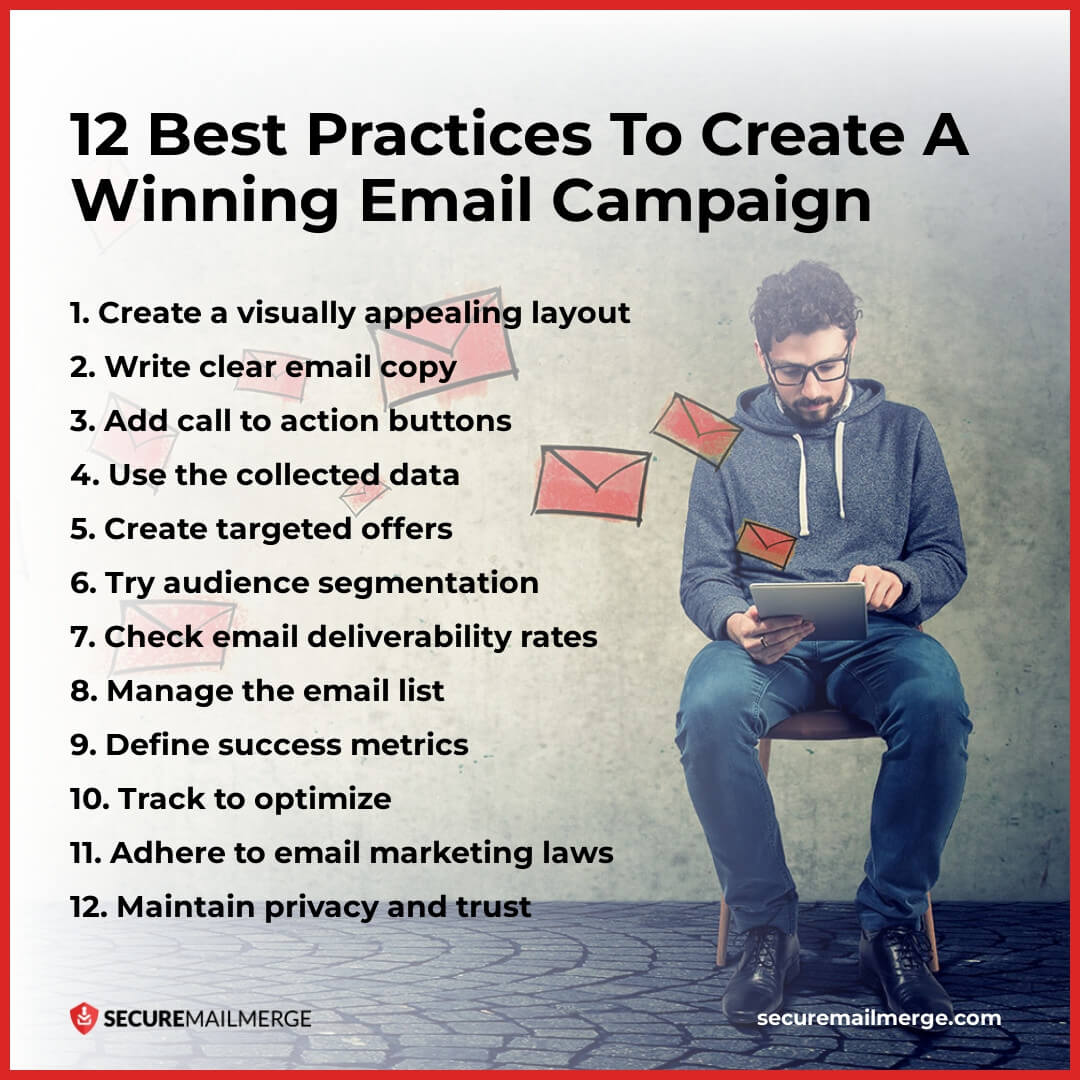
Email Design
Visually Appealing Layout
-
A well-designed layout can guide the reader’s eye and highlight important information, making it easier for them to digest the content and take action.
-
A visually appealing layout can also contribute to a positive brand image, building trust and credibility with your audience and increasing the likelihood of long-term engagement.
Clear and Concise Content
-
Clarity and brevity can keep your reader’s attention and prevent them from losing interest or being overwhelmed by excessive information.
-
Concise content can improve the readability and accessibility of your emails, making them easier to consume for a broader audience.
Call-To-Action (CTA) Buttons
-
CTA buttons provide clear and direct instructions to the reader, guiding them towards taking a specific action, such as purchasing, signing up for a newsletter, or downloading a resource.
-
Practical CTA buttons should be compelling, easy to understand, and consistent with the overall messaging and branding of the email, creating a cohesive and persuasive user experience.
Content Personalization
Leverage and Collect Data
-
Data-driven insights can help you better understand your audience’s preferences, behaviors, and interests, allowing you to personalize your email content and targeting to improve engagement and conversions.
-
Leveraging data and analytics can also help you identify trends and patterns across your audience segments, allowing you to develop more effective and targeted email campaigns that resonate with specific groups of subscribers.
Subject Lines and Targeted Offers
-
Targeted subject lines can capture the reader’s attention and entice them to open your email, leading to higher engagement rates and improved email performance.
-
Tailored offers provide relevant and valuable incentives that align with the recipient’s interests and needs, which can increase conversion rates and foster stronger relationships with your subscribers.
Audience Segmentation
-
By dividing your email list into segments based on demographics, behaviors, and interests, you can send more relevant and personalized content that resonates with each group.
-
Segmentation can also help you identify areas for improvement in your email marketing strategy, as you can track the performance of different segments and make data-driven decisions based on their behavior and preferences.
Information Management
Email Deliverability Rates
-
By dividing your email list into segments based on demographics, behaviors, and interests, you can send more relevant and personalized content that resonates with each group.
-
Segmentation can also help you identify areas for improvement in your email marketing strategy, as you can track the performance of different segments and make data-driven decisions based on their behavior and preferences.
Manage Your Email List
-
By dividing an email list into segments based on demographics, behaviors, and interests, brands can send more relevant, personalized content that resonates with each group.
-
Segmentation can also help identify areas for improvement in a given email marketing strategy, as marketers can track performance across different segments and make data-driven decisions based on their behavior and preferences.
Tracking and Metrics
Define Key Performance Indicators (KPIs).
-
Track metrics like open rates, click-through rates, and conversions to gain valuable insight into campaign performance across large data sets.
-
Over time, metrics and KPIs can help identify trends, spot areas of underperformance, and make strategic adjustments to enhance engagement.
Track to Optimize
-
Tracking metrics allows for A/B testing of subject lines, content, and design, helping brands optimize campaigns through data-driven decisions and improve overall email performance.
-
Metrics provide a deeper understanding of subscriber behavior, preferences, and engagement patterns, enabling targeted content creation and segmentation to deliver more relevant and personalized emails.
Compliance
Email Marketing Laws
-
Since email marketing involves personal details and contact information, ensure awareness of data privacy and email marketing laws.
-
Compliance with laws like CAN-SPAM and the General Data Protection Regulation (GDPR) is crucial to avoid legal repercussions.
Maintain trust
-
Respecting data privacy builds a positive brand image, fosters customer trust, and helps establish long-term relationships with subscribers, ultimately contributing to better email marketing performance.
-
Maintain subscriber trust by ensuring your audience consents to receiving your communications. Be sure to provide explicit opt-in and opt-out options, honor unsubscribe requests promptly, and handle personal data securely,
Essential Elements of a Successful Email Marketing Campaign
Below is an overall checklist to help streamline developing and executing an email campaign.
Use these points as a roadmap to keep you organized and focused on delivering impactful messages.
-
Clear and compelling subject line: A subject line should be attention-grabbing and relevant to the email content.
-
Personalization: Personalization helps to make the email feel more tailored to the recipient and can improve open rates and engagement.
-
Engaging and relevant content: The email content should provide value to the recipient, be easily read, and include a clear call-to-action.
-
Mobile optimization: Most people access their emails on mobile devices, so the email must be optimized for mobile screens.
-
A clean and visually appealing design: The email design should be visually appealing, on-brand, and easy to navigate.
-
A targeted and well-segmented email list: Segmenting the email list based on customer behavior, demographics, and preferences can help increase engagement and conversions.
-
A clear and prominent call-to-action: The call-to-action should be clear, easy to find, and encourage the recipient to take the desired action.
-
Timing and frequency: The timing and frequency of emails should be based on the recipient’s behavior, preferences, and campaign goals.
-
Personalized follow-up: A personalized follow-up email can help increase engagement and conversions.
-
Measurable metrics: Measuring and analyzing open rates, click-through rates, and conversion rates can help optimize the campaign for better results.
Tools and Resources for Email Marketing Strategy
Leveraging advanced tools and technologies can significantly enhance personalization and automation.
Three essential tools crucial in ensuring personalized and consistent email campaigns are Customer Relationship Management (CRM) systems, Email Service Providers (ESPs), and Marketing Automation platforms are three essential tools crucial in ensuring personalized and consistent email campaigns.
CRM Systems
CRM systems are designed to manage and analyze customer interactions and data throughout the customer lifecycle. They enable businesses to store and organize customer information, track engagement, and create segmented lists for more personalized email campaigns.
Popular CRM systems include HubSpot CRM and Zoho CRM.
Email Service Providers
Email Service Providers (ESPs) are specialized platforms that facilitate the sending and management of email campaigns. They offer features like email templates, list management, and analytics to track campaign performance.
ESPs also provide personalization capabilities, allowing you to insert customer data into emails dynamically. Examples of widely used ESPs include Mailchimp, Constant Contact, and Sendinblue.
Marketing Automation
Marketing Automation platforms offer a comprehensive suite of tools beyond email marketing. They allow you to automate marketing activities, including email campaigns, lead generation, and customer segmentation.
Popular marketing automation platforms include Marketo, Pardot, and ActiveCampaign.
Resource for Outlook Users
While CRM systems, ESPs, and marketing automation platforms are essential for effective email marketing, Secure MailMerge complements these tools by providing specific functionalities that streamline sending personalized email campaigns directly from Outlook. It offers features such as sending tailored emails to curated lists, leveraging contact details from spreadsheets or address books, handling large attachments, personalizing emails, and utilizing rich formatting options.
SecureMailMerge is a convenient solution for Outlook users who want to leverage the power of personalization and automation without relying on separate tools or platforms. Seamlessly integrating within Outlook simplifies the email marketing process and eliminates the need for additional software installations.
Look at our guidelines on how to start from creating your spreadsheet to starting the Secure MailMerge Add-In - compose and send your campaign all from within Outlook.
Enjoyed this article?
We have a whole library of useful articles for you to read
Show me the library of Outlook articles